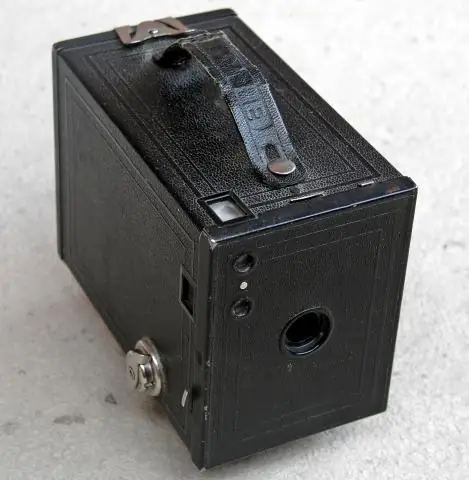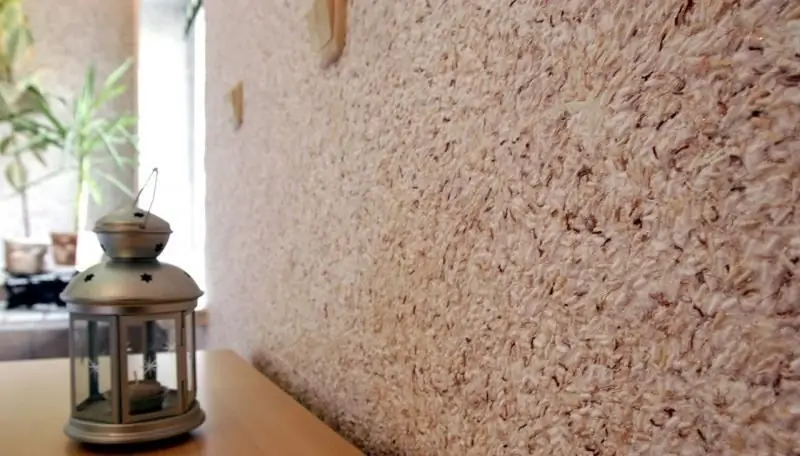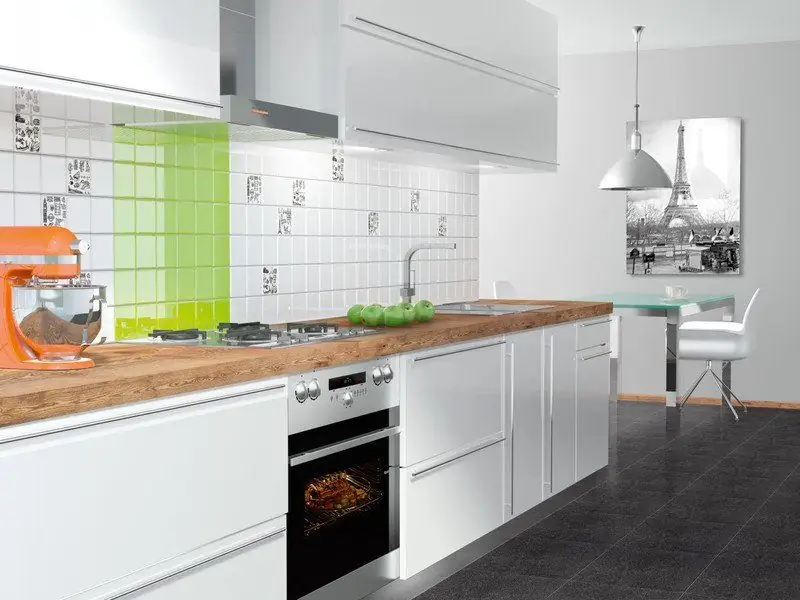
Table of contents:
- Author Bailey Albertson [email protected].
- Public 2023-12-17 12:53.
- Last modified 2025-01-23 12:41.
Practical decoration: laminate kitchen apron

A kitchen apron is a surface above the work area that protects the walls from contamination during cooking. Accordingly, it must be resistant to wear and tear, exposure to temperature and moisture, easy to clean and at the same time attractive to look. Consider whether such a common finishing material as laminate is suitable for this purpose.
Content
- 1 Advantages and disadvantages of a laminated apron
- 2 Types of laminate, composition, material selection criteria
-
3 Recommendations for installing an apron with your own hands
- 3.1 Surface preparation
-
3.2 Installation on battens
3.2.1 Video: Laying the laminate on the battens
-
3.3 Glue method
3.3.1 Video: how to install a laminate apron with glue
- 4 Tips for care
-
5 Kitchen design with laminated apron
5.1 Video: laminate aprons ideas
Advantages and disadvantages of a laminated apron
Laminate wall covering has the following advantages:
- easy to clean. To get rid of simple dirt, it is enough to wipe it with soapy water, in the case of more complex ones, you can use any chemical agents, while the laminate will not lose its quality and visual appeal;
- resistant to moisture (applies only to moisture resistant laminate);
- easy to install - it is easier and faster to lay it than traditional tiles, and there will be practically no dirt in the process;
- has a long service life in the absence of mechanical stress;
- differs in a low price;
- has a rich assortment of colors and textures;
- imitates the look and structure of natural wood, stone or tiles, it is matte and glossy, structured;
- consists of environmentally friendly material.

The whole wall can be decorated with laminate
Disadvantages:
- ordinary non-waterproof laminate shrinks from moisture;
- not resistant to high temperatures (cannot be installed next to a gas stove - the distance to it must be at least 10 cm).
Types of laminate, composition, material selection criteria
Laminate coatings are divided into several varieties, depending on the composition and installation method:
-
MDF. Inexpensive panels that can be installed on all types of battens. The disadvantage is the instability to moisture.

Kitchen apron made of MDF MDF - the most budgetary coverage
-
Chipboard. Stronger than MDF, they are attached without crate using plastic dowels, but they also absorb moisture. Unlike MDF, they have non-laminated ends, therefore, during installation, you will need a special profile for the edge.

Apron made of laminated chipboard Chipboard can be photoprinted
- Laminated hardboard. Possesses good density, does not allow moisture to pass through. Installed on a frequent crate.
- Laminate flooring. Durable, can also be used as a wall covering. Mounts to the lathing or directly to the wall, but the surface must be perfectly flat.
All types of laminate are composed of the following layers:
- the base layer of wood fibers, providing strength, the remaining layers are applied to it;
- cellulose impregnated with a water-repellent compound;
- a decorative layer that imitates various textures;
- protective coating made of acrylic resin with special additives.

All types of laminate are composed of several layers
For an apron in the kitchen, it is recommended to select panels of 31 or 32 strength classes. They are also the most moisture resistant. The environmental safety class must be E1. Other labels may contain toxic substances - formaldehydes.

For the apron, a waterproof laminate of 31 or 32 wear resistance classes is optimal
DIY apron installation recommendations
There are two mounting methods:
- glue - the laminate is attached with glue or liquid nails to a smooth unplastered wall;
- on the crate - a structure of slats or bars is pre-attached.
For styling, you will need tools:
- hand saw or jigsaw;
- a hammer;
- Ruler and pencil;
- building level;
- electric drill;
- wooden block;
- wooden slats (for lathing);
- silicone (in the case of the adhesive method);
- screws, nails.
Surface preparation
It is not necessary to lay the laminate immediately after purchase, it must first adapt to the humidity and temperature of the apartment, otherwise it may warp after installation. Therefore, the material is kept for 48 hours.
To prepare the wall, all furniture is removed from it, cleaned of old finishes and dust. The surface is leveled with a putty.
Experts recommend laying a plastic wrap under the apron for better protection from moisture. Its edges should go beyond the laminate by at least 5 cm.
Installation on lathing
With this installation method, the wall does not need to be perfectly flat. The structure is easy to assemble:
-
Bars measuring 4x4 cm are attached to the wall at a distance of 30-50 cm from each other using dowels. The lathing can occupy the entire wall or part of it.

Installation of battens The bars are placed at a distance of 30-50 cm from each other
- After that, check all the bars so that they are on the same level.
- The first panel is started from the lower right corner. The spike should be near the surface. During installation, the laminate sheet rests on the crate.
-
The second panel is pressed at a 45 ° angle. You need to fasten the sheet in the end groove of the first part. The rows are assembled in stages.

Fastening the laminate to the batten Panels can be fixed to the lathing with glue
- Fix the laminate to the lathing with screws. If necessary, the panels are adjusted to each other with a hammer.
Video: laying laminate on a crate
Glue method
Since the laminate will be attached directly to the wall, be sure to check the surface with a level. If the walls are not even enough, they are upholstered with plasterboard. In some cases, installation is possible directly on an old tile backsplash. Attachment sequence:
- The laminate is fastened together using special adhesives.
-
Apply glue to the back of the panel. It is recommended to use silicone rather than "liquid nails". Although these substances have similar adhesive properties, silicone is more fluid, which allows the material to be pressed as close to the wall as possible without the formation of bumps and unevenness.

Glue application Glue is applied to the back of the panel
- The panel is pressed tightly against the wall and kept for some time for the composition to set.
- The ends and groove of the material are processed with an adhesive. Then carefully install the spike of the next panel. Remains of glue must be removed immediately with a damp cloth, otherwise it will be very problematic to remove the dried composition from the surface.
- The second row fits in the same way. If cracks form at the joints during the connection, you need to treat them with a sealant. The grout is applied with a soft spatula.
- After installing the second row, the process is stopped for several hours. During this period, the glue hardens, which greatly facilitates further installation.
Video: how to install a laminate apron with glue
Care Tips
After installation, the laminate is cleaned of debris and dirt. It is enough to rinse it with plain water. Detergents are used to remove grease and dirt during operation.
If scratches appear, you can use a wax pencil to match the color of the coating - apply it to the damaged area and polish with a dry cloth. Water damage can be restored by wax on its own - if applied to the entire surface, it will create a protective film.
Deep scratches are repaired with a special laminate putty, which is sold in hardware stores in powder form. To get rid of the damage:
- Dilute the powder according to the instructions.
- They clean the surface from dirt.
- Apply the product with a spatula, trying not to go beyond the scratch. If this happens, the excess must be removed as quickly as possible before the putty has dried.
- After drying (half an hour or an hour), the surface is polished with a dry cloth.
Kitchen design with laminate apron
When choosing a laminate for the interior of the kitchen, you need to take into account its main colors:
- traditional - birch, cherry, oak, wenge, walnut, both dark and light;
- neutral and pastel - ash, light birch, light alder, light oak;
- cold - milky, cream, shades of gray, white oak.
A kitchen apron in shade and texture should be in harmony with the overall interior design, while it looks better when the wall covering matches the tone of doors, platbands or window frames. Decorating it in the same color as the floor is not a very aesthetic solution.

The apron is often made in the same tone as the table top.
Decorating the area above the work surface with laminate can be appropriate in almost all interior styles. In this case, it is only important to choose the right type of coverage:
- Panels with the texture of old art parquet will best fit into classic interiors, as well as Empire, Victorian, Baroque, sometimes Art Deco or retro styles.
- Imitation of natural wood, depending on the shade and texture, is suitable for any design from classic to high-tech.
-
Aged plank textures are used in country, provence and shabby chic kitchens.

Laminate apron in Provence style kitchen The Provence style uses a laminate with the texture of natural boards
-
Laminate in cold shades will look spectacular in gothic interiors (it is better to choose panels in dark colors), as well as in high-tech style. In some cases, a similar apron will be appropriate in Provencal cuisine.

Dark laminate wall Laminate in dark shades looks impressive
- Panels with a bright pattern and 3D drawings are suitable for modern kitchens, minimalism, hi-tech.
In sunny rooms decorated in light colors, a laminated apron with a matte finish in neutral natural colors will look good. For dark and cramped kitchens, it is better to use light glossy surfaces.

An apron with a wood texture accentuates light furniture fronts
If a panel with a pattern is installed, the size of the pattern must correspond to the dimensions of the room. An apron with a large ornament in a small kitchen will look bulky and attract unnecessary attention.

An apron with a large pattern is better for spacious kitchens
My friends have a laminated apron. After a short time of operation, in some places it began to bend and spring. Yes, and such a coating looks, in my opinion, not too presentable. Of course, this option is very good as a temporary measure, when a major overhaul is only planned, or for tenants of apartments in the style of "grandmother's chic", if you want to close the old tiles, but the owner does not agree to expensive repairs. But for a thorough renovation in my own apartment, I personally prefer ceramic tiles.
Video: laminate aprons ideas
The laminated apron is the ideal choice for those looking for a quick and dirty renovation. This is a practical, inexpensive and easy-to-install coating that suits almost all interior styles, and with proper care, it will last a long time and will delight the eye, not inferior to classic materials.
Recommended:
Apricot Red-cheeked: Description And Characteristics Of The Variety, Advantages And Disadvantages, Planting And Care Features + Photos And Reviews

Rules for growing apricot varieties Krasnoshekiy: planting, plant care. Pest and disease control
Raspberry Eurasia - Description Of The Variety, Photos And Characteristics, Advantages And Disadvantages, Planting And Care Features With Photos And Reviews

Description of remontant raspberry Eurasia, features of planting, care, advantages and disadvantages of the variety. Photo and video
Waterproof Laminate For The Kitchen: Composition And Properties, Pros And Cons, How To Choose The Right One, Examples With Photos

What is a waterproof laminate, its structure and properties, advantages and disadvantages. Selection recommendations. Laying waterproof laminate. Care Tips
Liquid Wallpaper In The Kitchen: Characteristics And Features, Advantages And Disadvantages, Photos Of Bright Ideas

Features of the use of liquid wallpaper, their pros and cons, selection options. How to properly apply liquid wallpaper on the walls, create a drawing and decorate the kitchen
Ceramic Tiles 10x10 For The Kitchen: Features, Advantages And Disadvantages, Main Application, Examples With Photos

10x10 cm tiles: features, advantages and disadvantages. Selection recommendations. Kitchen design options with square tiles. Styling tips
